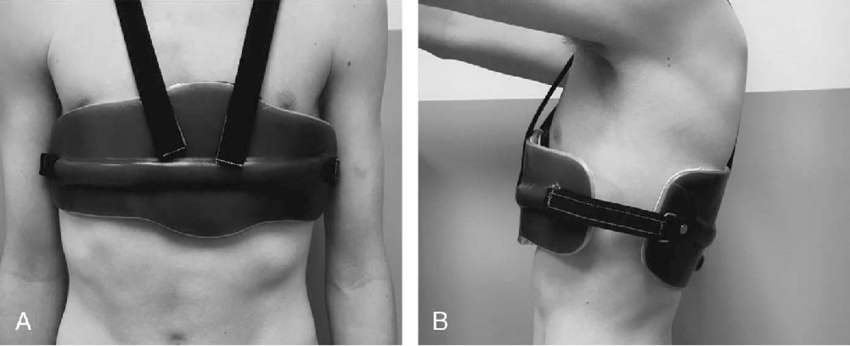Patient-reported efficacy of the UCSF custom Pectus carinatum orthosis
| Chrysta Irolla MS MSPO CPO is a recipient of the 2021 Howard R. Thranhardt Award |
| Irolla will present Treatment Parameters for the UCSF Pectus Carinatum Orthosis: A Pilot Study. More information about the 2021 National Assembly is available at AOPAnet.org |
| Irolla is the clinical manager and residency mentor at the University of California, San Francisco Orthotics and Prosthetics Center. She explored her interest in patient rehabilitation while obtaining her MS in Engineering Design from Northwestern University and subsequently decided to focus on patient care and get her MSPO from The Georgia Institute of Technology. |

Figure 1. A, Anterior view of the UCSF-PCO. B, Lateral view of the UCSF-PCO. UCSF-PCO indicates custom. University of California, San Francisco, Pectus Carinatum Orthosis. Uploaded by Chrysta Reana Irolla.
| Introduction |
Pectus carinatum is a bony deformity of the anterior chest wall and has a strong negative impact on patient self-esteem and quality of life. During adolescence, the deformity is often flexible and can be treated with a compressive orthosis. The purpose of this study is to evaluate the compliance to and patient satisfaction with the custom University of California, San Francisco (UCSF), Pectus Carinatum Orthosis (PCO) design.
| Materials and Methods |
This was a cross-sectional survey of the patients who received orthotic treatment for pectus carinatum at UCSF between August 2012 and June 2018. Potential subjects were contacted and asked to complete the Pectus Carinatum Evaluation Questionnaire (PCEQ), which was administered online via Research Electronic Data Capture. The PCEQ measures compliance as well as the physical and psychosocial impact of orthotic treatment for pectus carinatum. Results were compiled and summarized using nonparametric descriptive statistics.
| Results |
Of the 35 consented subjects, 12 (11 male patients and 1 female patient aged 12–17 years) completed the survey. Subjects reported an average wear time of 12.7 hours per day, 5 days a week. Seven reported no symptoms, three experienced chest pain, two reported difficulty breathing, and one had back pain. Eight reported happiness with the results of their orthotic treatment.
| Conclusion |
Wear times reported by the subjects were comparable with those reported in other studies looking at prefabricated pectus orthoses. However, there were lower reports of pain associated with the UCSF treatment than in other studies. Further research is necessary to determine the benefit of custom fabricated versus prefabricated PCOs.
| References |
Patient-Reported Efficacy of the University of California, San Francisco, Custom Pectus Carinatum Orthosis, Stauffer, Samantha MSOP; Shirley, Corin MPO, CO; Fortson, Benjamin MPO, CPO; Henry, Nicole MPO, CPO; Irolla, Chrysta MS, MSPO, CPO; Padilla, Benjamin MD. Journal of Prosthetics and Orthotics. April 2021 – Volume 33 – Issue 2 – p 96-100. doi: 10.1097/JPO.0000000000000358. Uploaded by Chrysta Reana Irolla.
Pectus Carinatum Evaluation Questionnaire (PCEQ): a novel tool to improve the follow-up in patients treated with brace compression, Pessanha I, Severo M, Correia-Pinto J, Estevão-Costa J, Henriques-Coelho T. Eur J Cardiothorac Surg. 2016 Mar;49(3):877-82. doi: 10.1093/ejcts/ezv198. Epub 2015 Jun 9. Full text, PDF
| Further reading |
Bracing of pectus carinatum: A quantitative analysis, Bugajski T, Murari K, Lopushinsky S, Schneider M, Ronsky J. J Pediatr Surg. 2018 May;53(5):1014-1019. doi: 10.1016/j.jpedsurg.2018.02.034. Epub 2018 Feb 13.
External Compressive Bracing With Initial Reduction of Pectus Carinatum: Compliance Is the Key, Fraser S, Harling L, Patel A, Richards T, Hunt I. Ann Thorac Surg. 2020 Feb;109(2):413-419. doi: 10.1016/j.athoracsur.2019.08.026. Epub 2019 Sep 23. Full text
Effectiveness of Compressive External Bracing in Patients with Flexible Pectus Carinatum Deformity: A Review, Hunt I, Patel AJ. Thorac Cardiovasc Surg. 2020 Jan;68(1):72-79. doi: 10.1055/s-0039-1687824. Epub 2019 Apr 25.
Initial reduction of flexible pectus carinatum with outpatient manipulation as an adjunct to external compressive bracing: technique and early outcomes at 12 weeks, Fraser S, Richards T, Harling L, Patel AJ, Hunt I. J Pediatr Surg. 2020 Jul;55(7):1347-1350. doi: 10.1016/j.jpedsurg.2019.09.024. Epub 2019 Nov 1.
Long-Term Results of Compressive Brace Therapy for Pectus Carinatum, Moon DH, Kang MK, Lee HS, Lee S. Thorac Cardiovasc Surg. 2019 Jan;67(1):67-72. doi: 10.1055/s-0038-1669927. Epub 2018 Sep 14.
Measured dynamic compression for pectus carinatum: A systematic review, de Beer SA, Blom YE, Lopez M, de Jong JR. Semin Pediatr Surg. 2018 Jun;27(3):175-182. doi: 10.1053/j.sempedsurg.2018.06.001. Epub 2018 Jun 15. PMID: 30078489.
Evaluation of the treatment of pectus carinatum with compressive orthotic bracing using three dimensional body scans, Wong KE, Gorton GE 3rd, Tashjian DB, Tirabassi MV, Moriarty KP. J Pediatr Surg. 2014 Jun;49(6):924-7. doi: 10.1016/j.jpedsurg.2014.01.024. Epub 2014 Feb 3.
Pectus Carinatum: To Brace or Not to Brace—A Picture Is Worth 1770 Words, Nehra, Deepika MD; Ein, Sigmund H. MD; Tlumacki, Mark CO; Masiakos, Peter T. MD. JPO Journal of Prosthetics and Orthotics. 2009 – Volume 21 – Issue 3 – p 167-170 doi: 10.1097/JPO.0b013e3181b2cd81
Also see
☞ Pectus carinatum causes, symptoms and treatment
☞ The Calgary Protocol: bracing for Pectus carinatum
